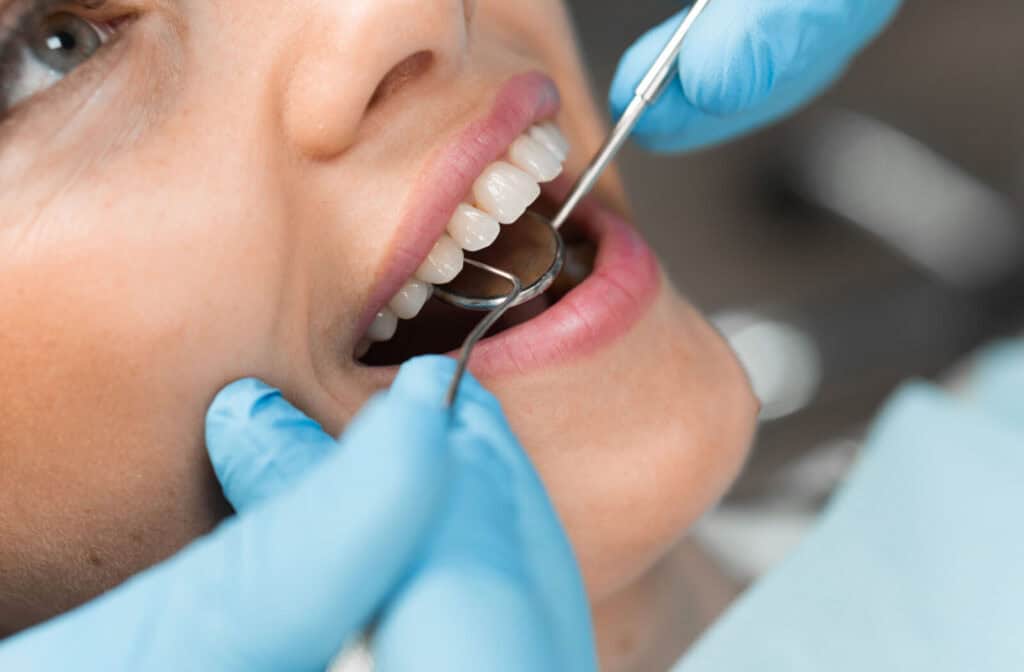How Can You Tell if Your Gums Are Receding?
Without proper, regular care, you might start to notice redness, aesthetic changes, and discomfort. Lack of care can lead to many dental concerns, including gum recession. This is a common problem that can lead to more serious dental issues if left untreated.
Visible redness, bad breath, and overall irritation may indicate that your gums are receding. Your teeth may appear larger—or longer—than they were before. If you notice any of these signs, visit your dentist as soon as possible to help prevent future problems.
What Is Gum Recession?
Gum recession occurs when the gum tissue surrounding the teeth wears away or pulls back. It can be visually alarming as it can make teeth appear longer than normal. However, in addition to being an aesthetic concern, gum recession also has severe implications for your overall oral health.
When your gums recede, more of the tooth or its root become exposed, creating gaps where bacteria can breed and thrive. If left untreated, these pockets can cause severe damage to the supporting bone structure of the teeth, eventually leading to tooth loss.
What Causes Gum Recession?
The leading cause of gum recession is gum disease. This develops when bacteria infect the small pockets around your gums and teeth.
You can break gum disease into 2 categories:
- Gingivitis: This is the early stage of gum disease. It can be reversed with proper oral hygiene, a balanced diet, and regular dental visits. If left untreated, gingivitis can become a worsened form called periodontitis.
- Periodontitis: This is an advanced form of gum disease that requires more intensive treatment to manage and prevent further complications. If left untreated, periodontitis can cause severe infections, permanent damage, and tooth loss.
Gum recession can lead to permanent damage, making early intervention crucial to prevent further problems.
Other Common Causes of Gum Recession
This condition can affect anybody—even those with good oral hygiene habits. However, it becomes much more likely depending on factors such as:
- Poor oral hygiene
- A genetic disposition to dental conditions and gum disease
- Smoking and tobacco usage
- Poor nutrition and an unhealthy lifestyle
Age can also play a factor, as receding gums are more common in adults over 40 years old. However, gum recession is not a normal part of aging and requires prompt treatment.
Common Signs of Receding Gums
Usually, the first sign of receding gums is sensitivity. You may find yourself more sensitive to cold or hot foods, and you might even notice bleeding when you brush and floss.
Other common signs of receding gums include:
- Redness and swelling in the gums
- Tenderness in the gums
- Pain at the gum line
- Noticeably exposed tooth roots
- Loosening teeth
- An unpleasant taste in the mouth
If you notice any of these signs, consult a dental professional immediately. Early intervention can help prevent more severe dental issues and help you protect your teeth and gums against infection and tooth loss.

What to Do if Your Gums Are Receding
You should never leave dental problems untreated. If you suspect that your gums are receding, take immediate action and visit your dentist for a cleaning and exam. They can determine the best treatment plan to help protect your gums and your teeth.
During your appointment, your dentist can examine your teeth and gums to determine the extent of your damage. They may also take X-rays to see if the underlying bone structure is affected.
Depending on your specific situation, your dentist may recommend different treatments, such as:
- Scaling and root planing: This deep cleaning procedure removes plaque and tartar buildup from below the gum line.
- Antibiotics: If an infection is present, antibiotics may be prescribed in addition to other treatments.
- Plaque control: Your dentist may give you personalized advice to help prevent plaque buildup in between dental visits.
In more severe cases, you may need surgery to replace lost gum tissue. These treatments can help prevent gum recession from worsening. However, in the earliest stages, you may be able to prevent this condition at home.
How to Prevent Gum Recession
Preventing gum recession starts with good oral hygiene habits:
- Brush your teeth twice daily with a soft-bristled toothbrush.
- Floss regularly to remove plaque and food particles.
- Use an antimicrobial mouthwash to reduce bacteria.
- Maintain a balanced, nutritious diet rich in vitamins and minerals.
You should also avoid tobacco products, as smoking fosters the growth of bacteria that can lead to gum disease.
The final step is to regularly visit your dentist for comprehensive checkups and examinations. Your dentist can monitor your dental health and treat issues early.
Protect Your Smile Against Receding Gums
Gum recession is a common but serious dental issue, and you should never leave it unaddressed. If you’re worried about receding gums, visit our team at South Ancaster Family Dental—our team knows how to help.Whether your symptoms are caused by gum disease, cavities, or any other dental problem, we can help restore your smile. Request an appointment with our team today, and take the first step to protecting your smile.

